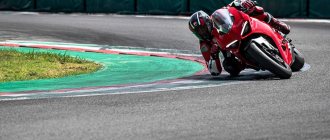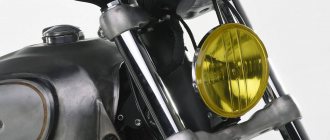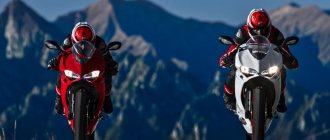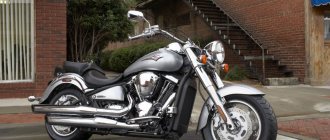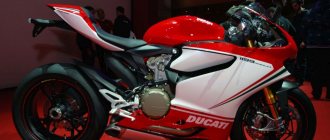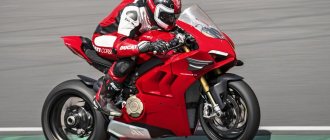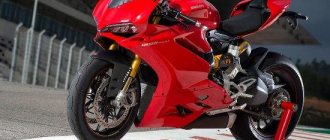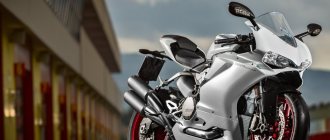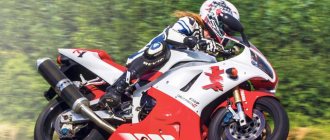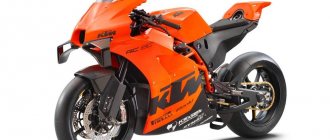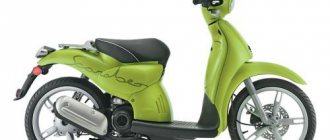For several years now, the Ducati 1199 Panigale has been an icon of the superbike class with its 195 hp. power with a weight of only 164 kg. But not every pilot needs these almost 200 horses between his legs when driving on regular roads, and even for that kind of money. This is probably why the enthusiasm for the 1199 Panigale remained just enthusiasm on the Internet, without adding the expected mountains of gold to the Ducati treasury. But in our time, any good project is only good if it generates income. So directives from the head office of Audi (the current owner of Ducati) flew to the headquarters of the “Reds” with demands to understand the current situation. In response, the Italians rolled out the Ducati 899 Panigale - a budget version of the “older” Panigale, with a medium engine capacity and an attractive price. Is this device capable of surprising our brother motorcyclist?
I asked myself this question while flying over the ocean to America for my first test for journalists. As I studied the specs, I was amazed that the 899 had a lot in common with its older brother. There are much fewer differences! When making engine covers, cheaper aluminum is used instead of magnesium alloy. The newcomer does not have a slipper clutch system, but there is an Electronic Braking Control system. The rear sprocket and quick shifter have been increased by 5 teeth (up to 44 teeth) - all this together improves acceleration dynamics. The reduction in price also affected the steel subframe and fork from Showa instead of Marzocchi. The rear uses a conventional double-sided aluminum swingarm, as opposed to the cantilever swingarm of the 1199 Panigale. The front brakes, although Brembo, have M4 calipers, which are also lower in specification than the older models. In general, the budget is quite relative. And compared to Japanese sportbikes of this class, the 899 Panigale equipment looks simply super-sophisticated. And an Italian bike will be sold for the same money! In the USA, for example, a price tag of $14,995 has been announced.
TIRES
The Pirelli Diablo Rosso Corsa holds up perfectly even in pouring rain.
I must say that the motorcycle looks excellent in person. Especially in the signature red color. However, the common body lines with the 1199 Panigale could not hide the important difference between the Panigale junior - the device is truly miniature, if not tiny. As if it was made not by tall Italians, but by compact Japanese. Once there, another feature of the motorcycle became noticeable - its saddle was noticeably thicker and more comfortable. Looking at the specs, I was expecting the bike to be slightly smaller than the 848 EVO. But having positioned the “fifth point” and grabbed the steering wheel, I realized that I was mistaken - it turned out to be much smaller! I suddenly, for the first time in many years, remembered the miniature Japanese “quarters” that I had dabbled with at the dawn of my motorcycle life.
But those “quarter cars” certainly couldn’t accelerate so powerfully or handle so well. All doubts instantly disappeared as soon as I took the first fast turn on the track with the breeze on the 899. True, the 899 cc engine only demonstrates its capabilities in the high rev range. This presents a certain challenge in normal off-track driving: to get optimal acceleration, you must always keep the tachometer needle above the first third of the scale. Gone are the days when it was possible to drive in high gear due to high torque. But the operating speed range is still wider than the equivalent 4-cylinder engine, and even wider than ever.
Advantages and disadvantages
The Ducati 899 Panigale motorcycles clearly have more advantages than disadvantages, and the latter stem mainly from the complexity of the design.
Advantages
- Crazy acceleration dynamics and high top speed.
- A complete set of auxiliary electronic systems that make it easier to control the motorcycle.
- Sophisticated aerodynamics , thanks to which the wind practically does not interfere even at speeds close to the maximum.
- Tenacious brakes with ABS , reliably stopping the bike even on wet asphalt.
- Attractive design , for which tens of thousands of motorcyclists love this model so much.
Flaws
- Problems with spare parts . They are usually out of stock, and there is a long wait for them to order.
- High cost of maintenance. Any repair is expensive, not least due to the fact that many service operations cannot be performed correctly without special equipment, which is available only from official dealers.
- Heavy clutch . In city traffic jams, your hand quickly gets tired of it.
- Sometimes, when changing gears, a false neutral .
Muffler
Mounted to lower center of gravity - pure track solution
Compact dimensions, low weight and the peculiarity of landing “on the front wheel” provide an unforgettable experience of aerobatics. Sport Mode gives a universe of impressions from the dynamics of acceleration and braking. I didn't find any negatives in the 899 Panigale on the track. Where I was wrong, electronics came to the rescue. And even in the rain, turning on the Wet mode, I didn’t feel like a cow on ice! But I still wouldn’t ride such a bike on ordinary streets. Why? There is too much sport in the “small” Panigale!
TEXT: LIU WASEDA
Technical characteristics of the Ducati Panigale 899
The Ducati Panigale 899 was the company's first mid-size sportbike equipped with a Superquadro engine . It can rightfully be classified as a supersport, above which there is practically nothing - it is the pure embodiment of power, speed and aerodynamics.
Engine
The 2-cylinder L-shaped engine produces 148 hp. and 99 Nm of torque, and it loves high speeds - peak power occurs at around 10,750 rpm . The engine capacity, equipped with a desmodromic valve drive , traditional for Ducati, is 898 cc. see. The maximum speed reaches 260 km/h , and from 0 to 100 km/h the bike can accelerate in 2.7 seconds .
Transmission
Classic 6-speed gearbox with chain drive and oil bath clutch. The technological delights of the Italian company mainly affect bike engines and their design, but in the transmission everything is quite familiar and traditional.
Chassis and brakes
The alloy monocoque frame of the Ducati 899 Panigale is perfectly combined with fully adjustable Showa suspension and tenacious Brembo brakes , additionally equipped with an ABS system . The designers' efforts to reduce weight were not in vain; the bike turned out to be light, quite compact (wheelbase - only 142.6 cm ) and easy to control. Two 320 mm brake discs , and one 245 mm disc . The efficiency of the braking system can be rated at the highest level.
Electronics
Here the Ducati Panigale 899 is equipped to the highest standard. Servicing a motorcycle in a garage yourself is very problematic because it is full of complex electronic components that control everything from the brakes to the gas handle. So owners will have to shell out money for visits to official dealers, who have all the necessary equipment for diagnostics. Nothing can be done - this is the price to pay for the technical excellence for which Moto Ducati and its Sport class motorcycles are famous.
Weight and dimensions
Thanks to the use of modern technologies, Ducati engineers managed to keep the weight of the motorcycle at a very modest level - the dry weight of the bike does not exceed 169 kg , and the curb weight - 193 kg . The Panigale 899 is 207.5 cm long and has a seat height of 83 cm. Thanks to its well-thought-out ergonomics, this model is equally suitable for bikers of all sizes, and all they need to ride this plastic rocket is experience.
Controllability
Thanks to well-thought-out weight distribution, the Ducati Panigale 899 does not seem heavy at all, it obediently obeys the steering wheel (or rather, the clip-ons) and easily takes turns “with your knees” even at exorbitant speeds. Numerous auxiliary electronic systems, such as quickshifter and traction control, also contribute to handling. They are equipped with all versions of the Ducati 899 Panigale without exception.
Fuel consumption
It directly depends on the driving style. If you calmly drive along the highway at a speed of 120-130 km/h, gasoline consumption will not exceed 6 liters per hundred , but on the track or during aggressive city driving it can reach up to 10 liters . The bike is demanding on fuel quality, and it is advisable to fill its 17-liter gas tank only AI-98 from proven gas stations. Otherwise, the injector, which is sensitive to additives and impurities, may begin to malfunction, and repairs will cost a pretty penny.
A connoisseur's dream. Part 2
In the previous material, we examined in some detail the Ducati sports motorcycles produced from 1993 to 2006. Today, the next step is a story about more modern models and the general technical features of all the motorcycles we are considering.
1098 (2007–2008)
Italian engineers, having experimented with design as much as possible within the 999 model, decided to create something new, but at the same time as recognizable as possible. The 1098 model was such a responsible step, marking the beginning of a new stage in the evolution of the company’s sportbikes.
Only the lazy did not notice how well the designers did their job. The design of the front of the motorcycle has returned to the design with two horizontally positioned headlights. But all optics have changed dramatically towards more complex forms. The plastic has become more streamlined and sharply defined. The motorcycle as a whole looks surprisingly light and harmonious. According to many experts, this is the first aesthetically correct Ducati sportbike since the original Ducati 916.
The heart of the model was the Testastretta Evoluzione engine (at that time the most powerful V-type in history). It developed a record 160 hp. With. at 9750 rpm. The suspension, as expected, is entirely built on the highest quality components with a full range of adjustments. Progressive electronic systems include a data logger, an immobilizer and DTC traction control as an option. These gadgets then migrated to all subsequent models of the company (the 848 did not even have DTC as an option).
The special version 1098S differs from the basic version by the presence of Ohlins components all around, more powerful brakes and carbon fiber. 1098R (2008) is essentially a 1198. There is a traction control system on board, a new engine like the 1198, rear suspension with an Ohlins shock absorber. General TTX at the level of cars from the MotoGP world (180 hp at 9750 rpm). The cladding is made using carbon fiber.
The main problem with the Testastretta Evolusion engine (1098 and 1198) is that due to the fact that the degree of forcing of the piston group has noticeably increased and the increase in the load on the crankshaft supports has become much more significant, the left crankshaft bearing is running out at an accelerated pace. The generator rotor is very heavy (on sports versions this problem is solved by making the rotor lighter) and by the time it runs 40,000–50,000 km it wears out the bearing. The first sign is that the engine begins to howl noticeably. This repair rarely costs less than 100,000 rubles.
Starting with 1098, the overrunning clutch was changed, which caused a lot of problems for owners of “three nines”. Now its resource has risen to 25,000–30,000 km. But, nevertheless, the left side of the crankshaft remained overly loaded - in addition to the weighty generator rotor, there is also an intermediate shaft, which is responsible for the drive belts.
In 1098, 848 and 1198, due to the use of thin, easily bent plastic, the air filter box is steadily screwed in, and dirt from the front wheel begins to fall directly into the engine with all the ensuing features until the death of the power unit. The problem can and should be solved on your own by strengthening and gluing the standard airbox. These troubles appear even on new motorcycles after a year and a half of active use. A little mileage on a crooked box - and you can already plant potatoes on the air filter, but this is a minus for the engine. An insufficiently qualified mechanic who simply changed the filter on such a motorcycle and did not bother to eliminate the defect is also a minus for the engine. Just hoping it won't work, the vacuum in the filter is like in a cool modern vacuum cleaner.
848 (2008–2013)
The 848 is a smaller and more budget-friendly version of the Ducati 1098. The motorcycle is visually very similar to its older brother, but has a number of simplifications - a reduced engine size, simpler brakes and a wet clutch.
In 2010, the regular 848 was replaced by the EVO version. The new motorcycle features more powerful brakes borrowed from the 1098, a non-adjustable steering damper and a significantly upgraded, more powerful Testastretta engine (new cylinder head, cams, pistons, compression ratio increased to 13.2, upgraded fuel supply system).
1,198 (2009–2011)
The 1198 series consists of four different modifications - Ducati 1198, 1198S, 1198S Corse and 1198R Corse. All motorcycles are built around the lightest engine at the time of creation, Testastretta Evolusion 2 (170 hp). Thanks to new crankcase production technology, the weight was reduced by 3 kg. The pistons are taken from the company's racing designs. The Marelli injector is 13.3% more efficient than the 1098. All versions are equipped with the new Ducati Data Analyzer system (a kind of on-board recorder). The 1198S and 1198S Corse are equipped with proprietary traction control as standard, the 1198R Corse has this system as an option.
Visually, 1098 and 1198 are twin brothers. The only differences are in the wheels (the more recent model does not have bifurcated spokes) and the nameplates on board.
1199
Panigale (2011 – present)
The best track motorcycle of the 2000s, the best V2 engine in history (Superquadro), one of the most beautiful motorcycles of our time - and all this is the Ducati 1199 Panigale (Borgo Panigale is a small fishing town in Italy, where the Ducati factory is located). On board is multi-mode traction control (DTS), nine ABS operating modes, three power modes: rain - 120 hp. p., 195 l. With. smoothly, 195 l. With. and a bunch of other electronics and telemetry. A special charm is that the “liter-two hundred” in feel and size (but not in power) is more like a skinny “six hundred”. The engine was largely redesigned and the clutch assembly was immersed in an oil bath. There is no frame as such; the main load-bearing role is played by the engine.
Visually, the motorcycle is as delicate as possible and unlike anything the Italians have produced before. The front fairing was slightly blunted and acquired two bright arrow-shaped headlights, combined with huge air intakes. The side plastic has slightly decreased in size, and the tail unit has become even more compact, mainly due to the fact that the entire exhaust system is now hidden under the belly of the motorcycle, the exhaust gases are released almost under the rear wheel.
Naturally, there is also an S version, which sports electronically adjustable suspension (Öhlins NIX30 fork and TTX-36 shock absorber). Curb weight – 179 kg. A Corsa version with the Italian tricolor and an unusual exhaust will also be available.
In 2014, Ducati began production of the Ducati 1199 Superleggera superbike, a super-light version of the Panigale. The motorcycle with a record power-to-weight ratio is entirely made of super-light materials, with a total curb weight of 155 kg. A total of 500 copies were produced. That same year, a matte black version of the Dark Stealth was introduced. The only differences are in the coloring.
Buying such a motorcycle not for sports use is more of an image move. For civilian use, the motorcycle will not be able to reach its full potential and will require extremely expensive maintenance.
899
Panigale (2013 – present)
899 is obviously a simplified and smaller copy of the adult Panigale. It is based on the same chassis and Superquadro engine. The volume of the power unit is 898 cm3 (148 hp at 10,750 rpm, 193 kg curb weight). The electronics equipment is quite serious: electronic throttle control, a customizable engine control unit ECU (Race, Sport, Wet), an eight-level traction control system and a three-level anti-lock braking system, Engine Brake Control. The stock six-speed Ducati 899 Panigale gearbox with quickshifter is identical to the one found on the Ducati 1199 Panigale. Visually, the new motorcycle is almost a copy of the Ducati 1199 Panigale, with the exception of the usual double aluminum swingarm.
No serious bottlenecks were identified in the two new products due to the insufficient amount of operating statistics, one thing is clear - falling on these motorcycles is extremely expensive! It’s not a fact that the Panigale family will live up to the full scope of the Italians’ hopes, but it has already become a global bestseller.
Modern Ducati sportbikes, in a certain sense, can immediately be considered luxury. Pricing in everything, including ordinary services, differs greatly from its Japanese counterparts. In other words, if you don’t have a sufficient amount of money, it’s better not to get involved in this segment. The relatively budget 848 can be considered an entry ticket. On the secondary market, supply for all models exceeds demand. After all, motorcycles are too much for everyone and it will not be easy to resell them. Service is also a thing in itself.
General technical features
In Russia, we mostly grew up on Japanese sports motorcycles, and some design features of Ducati may at first glance seem at least strange. However, the engineering component of Italian motorcycles is extremely well thought out. Yes, they are not so ultra-reliable, but they cannot be called fragile either. The bottom line is that almost every sports model (and these are the majority) is already in its standard version (and the R version especially) is ready to go on the track and show good results. But for the best racing technologies you have to pay triple the price during maintenance, which is quite natural.
The L-shaped motor is very reliable. The most important condition for its happy, problem-free existence is the proper oil level and timely maintenance. All water Ducatis do not like underheating. It is enough not to warm up the engine three or four times to fill the spark plug of the rear cylinder. Accordingly, it stops working correctly, periodically sneezes loudly and hits the engine in the opposite direction, destroying the overrunning clutch. A few impacts are enough for the clutch to start slipping. The essence of the problem is not in technology, but in heads. If you carefully study the operating instructions, it indicates the intervals for replacing spark plugs, which should, at a minimum, be observed, and, at a maximum, exceeded! Ducati engines are absolutely not demanding on the use of high-tech oils due to the fact that their foundations were laid in those years when no one knew about high-quality lubricants. A wheelie with front wheel lift angles of about 90° is definitely contraindicated for absolutely all Ducati motorcycles. The stopping factor for fans of such sophistications should be the cost of repairs. The gearbox takes care of itself enough that you don’t even think about it at all. Problems with gears not engaging or falling out are rare.
The factory engine cannot be called noisy. Yes, there is a characteristic rustling sound of a dry clutch (on those models that have it), but nothing more. The famous “bucket of nuts” sound is an indicator that it’s time to shake out the clutch. The louder the sound from the imaginary nuts, the greater the wear of the clutches and clutch basket and, accordingly, the closer the tragic ending. Of course, it’s not worth launching, it will cost more.
With sufficient knowledge of the hardware of the timing belt drive, problems do not arise at all. Its maintenance scenario is simple - periodic monitoring with replacement if necessary. The desmodromic drive is adjusted according to the technical documentation (every 12,000 km depending on the model); this work is best left to professionals.
It makes sense for the owner to immediately study in detail the procedure for correctly tensioning the final drive chain, otherwise even the slightest sag due to uneven powerful traction impulses from the engine will quickly lead to increased wear of the chain and sprockets, and will also add unpleasant jerks when starting from a standstill .
Unfortunately, marketing has completely killed the pleasure of service. If in classic models a plastic body kit, made according to sports traditions with quick-release fasteners, can be removed in a matter of minutes, then on modern Ducati sportbikes, in order to disassemble at least something, you need to use all possible skill, and this will not guarantee the success of the operation and the absence of a broken one fasteners The speed and ease of maintenance and repair have dropped many times over time. The plastic of modern Ducatis is a separate problem. Thin and brittle, after a year of operation it is screwed, ceasing to fit normally and losing all the gaps. This is not observed with older motorcycles even ten years later. Here I just want to quote our Ducati guru Zhenya Zheludkov: “The maintainability of motorcycles in old bodies is simply fantastic: disassembling and reassembling plastic takes two minutes, changing spark plugs takes five minutes, changing belts takes 20 minutes.”
Tuning
There is a great variety of tuning and accessories for Ducati motorcycles. The main demand is for aftermarket exhaust systems, various types of styling and cladding parts made of noble carbon fiber. Deep tuning for civilian purposes is extremely rare, mostly serious intervention in the design revolves around preparing the motorcycle for use on race tracks. There are a few large drag bikes known, but these are rather the exception to the general rule. It is important to understand that such aesthetically perfect motorcycles should not be sculpted with just anything. What is typical is that really beautiful and necessary parts cost quite a lot of money already at the stage of purchasing from European sellers.
Application
Naturally, the racing track should be the home of a sportbike, and Ducati sports motorcycles prove this in the best possible way. In general, nothing prohibits moving around the city, but you need to know when to stop. Travel should always have close to ideal asphalt and a minimum amount of traffic congestion. If you are going to use, say, a 916 or 1098 as a motorcycle for every day, and even in rural areas, fear God. Such conditions will negate all the pleasure of riding and significantly shorten the life of the motorcycle.
Crash tests
In terms of vulnerability when contacting asphalt, various obstacles and other road users, modern models (1098, 1198, 1199 and 899) fare somewhat worse than their more robust predecessors. Here, even a slight fall on the spot can cause a lot of problems. The Panigale family even with a moderate impact scatters like firecrackers. The plastic on these motorcycles is much thinner, more fragile and more expensive. The levers, paws and fasteners are as openwork as possible. With every small crash test, the owner is doomed to significant financial losses and a long wait for new parts.
Conclusion
Of course, we must give credit to the Italians, they know how to create beautiful equipment. But, frankly speaking, they were and remain artisans. In terms of bringing existing technologies to perfection, everything is fine, but with the development of new original original designs, conservatism is in its maximum manifestation. Let's take a look at sportbikes. For example, if we take away the absolute masterpieces represented by the Desmocedici (a rare example that goes beyond the material) and Panigale, it turns out that 1198 is still the same 916, but only 17 years later. The motorcycle has simply been changed to suit the context of a specific time; the main components, assemblies and patterns of their interaction are still the same. Only Harley-Davidson can afford to release one successful design onto the market and then upgrade it countless times. Ducati again turned to sports to save the situation. Panigale is definitely a step forward in development, but whether it will help bring back its former glory, we will find out in the very near future.
We express our gratitude to the “Evgeniy Zheludkov Workshop” for their assistance in preparing the material, www.royal-mc.ru, tel. 8 916-087-82-77.
Chic, shine, beauty >
Similar materials
A connoisseur's dream. Part 1
29 July 2014 13:37 Mikhail Pimus
Conclusion
The Ducati 899 Panigale is a magnificent sportbike, one of the best in its class . Unsurpassed aerodynamics, incredible power, stylish design and sophisticated electronic assistance systems make it truly the king of the road. But it takes a lot of experience to tame this wild Italian beast - it is not intended for beginners . And you should consider your financial capabilities when purchasing a Ducati Panigale, because this motorcycle is also not cheap to maintain.
Specifications
| Maximum engine power: | 148 hp at 10750 rpm HP |
| Torque: | 99 N•m at 9000 rpm Nm |
| Working volume: | 898 cm3 |
| Motor type (cylinder arrangement, number of strokes): | V-shaped |
| Number of cylinders: | 2 |
| Number of valves: | |
| Intake type (Injector / Carburetor): | |
| Bore and stroke: | |
| Starting system (Electric starter, kick starter): | |
| Maximum speed in km/h: | 260 km/h |
| Cooling system: | Liquid cooling |
| Transmission (gearbox): | Mechanical, 6-speed |
| Clutch (Dry / Wet): | |
| Drive unit: | Chain |
| Frame: | Aluminum, monocoque |
| Chassis | |
| Suspension (front/rear travel): | |
| Brakes (Front/Rear): | |
| Wheels / Tires / Rubber: | |
| Dimensions and weight | |
| Dimensions (Length / Width): | |
| Seat height: | |
| Ground clearance: | |
| Curb weight: | |
| Wheelbase: | 1426 mm |
| Weight: | 169 kg. Curb weight: 193 kg kg |
| Fuel tank capacity: | 17 l. |
| Battery capacity: | |
| Year of release: | |
| Country of Origin: |
Owner reviews
The motorcycle is thought out to the smallest detail, I don’t know what else can be compared with the Ducati Panigale. Before that I drove an Agusta 800, Dukas is much more interesting in comparison. You can safely squeeze out all their juices even in the rain, simply by turning on the appropriate engine operating mode. The brakes are perfect, you don't feel the weight at all. Igor, Moscow.
Strange bike, looks great, but there's something wrong with the saddle. I drove it for one season and sold it, it’s not my thing, but I ended up buying a Honda again. The seat is uncomfortable for the passenger, the electronics greatly limit the pilot's capabilities, and the footrests are slippery. The power also seems to be behind the scenes, but in reality it’s somehow not even felt. I wasn't impressed with the bike, especially for the money. Anton, St. Petersburg.
A dream came true, at the beginning of last season I bought a Panigale 899, 2014, beautiful, white, with a total mileage of 8 thousand. During the season I walked another 6 thousand kilometers, the flight was normal, no breakdowns. There are no feelings from the motorcycle other than delight, it’s not in vain that I saved almost money for it for two years - it is definitely the best in its class. If I change it for something in the future, it will only be for a new Panigale. German, Ekaterinburg.
Transmission and engine
The motorcycle's transmission includes a six-speed front gearbox, which is equipped with a constant, non-stop gear clutch. The transmission is also equipped with a wet multi-plate hydraulic clutch, as well as a main chain drive.
As for the engine, the first moment that is simply breathtaking is the high power and weight parameters that were provided by the most technologically advanced engine currently in existence - an engine called Superquadro. This engine in the Ducati Panigal 1199 is a 1198 cc unit with two cylinders.
There is liquid cooling as well as a gas distribution mechanism. In the process of creating this engine, the developers were able to achieve a significant reduction in the size and weight of the engine.
Another engineering decision made in the process of creating the engine for this motorcycle is the deflection of the cylinders relative to the crankcase by 6 degrees. Due to this engineering solution, the gap between the body and the front wheel has become larger. This helped with load redistribution.
The engine is equipped with an electronic fuel injection system, as well as two injectors for each cylinder.
Assistance systems in Ducati 1199
Excellent handling and performance parameters of the motorcycle, as well as a high level of control are provided by a complex of various auxiliary systems, including:
- ABS;
- Electronic unit responsible for braking control. This block is designed specifically to ensure vehicle stability in case of any sharp or simply dangerous turns;
- The system responsible for track control is complete. This system analyzes and processes data about how and at what speed the wheels rotate. This system shows recommendations on how best to combine innovative systems;
- Suspension tuning system;
- Quickshifter;
- System for managing power and its modes.
What is noteworthy is that modes are controlled while driving using just one single button. All necessary information for the driver will be displayed on a specialized TFT monitor.
